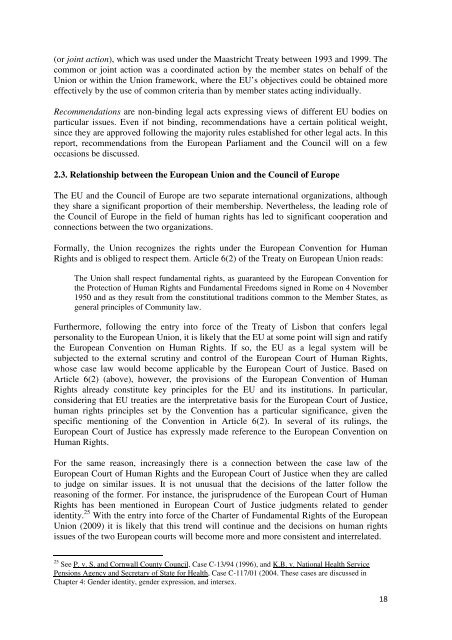Johanna Westeson - The ICHRP
Johanna Westeson - The ICHRP
Johanna Westeson - The ICHRP
Create successful ePaper yourself
Turn your PDF publications into a flip-book with our unique Google optimized e-Paper software.
(or joint action), which was used under the Maastricht Treaty between 1993 and 1999. <strong>The</strong><br />
common or joint action was a coordinated action by the member states on behalf of the<br />
Union or within the Union framework, where the EU’s objectives could be obtained more<br />
effectively by the use of common criteria than by member states acting individually.<br />
Recommendations are non-binding legal acts expressing views of different EU bodies on<br />
particular issues. Even if not binding, recommendations have a certain political weight,<br />
since they are approved following the majority rules established for other legal acts. In this<br />
report, recommendations from the European Parliament and the Council will on a few<br />
occasions be discussed.<br />
2.3. Relationship between the European Union and the Council of Europe<br />
<strong>The</strong> EU and the Council of Europe are two separate international organizations, although<br />
they share a significant proportion of their membership. Nevertheless, the leading role of<br />
the Council of Europe in the field of human rights has led to significant cooperation and<br />
connections between the two organizations.<br />
Formally, the Union recognizes the rights under the European Convention for Human<br />
Rights and is obliged to respect them. Article 6(2) of the Treaty on European Union reads:<br />
<strong>The</strong> Union shall respect fundamental rights, as guaranteed by the European Convention for<br />
the Protection of Human Rights and Fundamental Freedoms signed in Rome on 4 November<br />
1950 and as they result from the constitutional traditions common to the Member States, as<br />
general principles of Community law.<br />
Furthermore, following the entry into force of the Treaty of Lisbon that confers legal<br />
personality to the European Union, it is likely that the EU at some point will sign and ratify<br />
the European Convention on Human Rights. If so, the EU as a legal system will be<br />
subjected to the external scrutiny and control of the European Court of Human Rights,<br />
whose case law would become applicable by the European Court of Justice. Based on<br />
Article 6(2) (above), however, the provisions of the European Convention of Human<br />
Rights already constitute key principles for the EU and its institutions. In particular,<br />
considering that EU treaties are the interpretative basis for the European Court of Justice,<br />
human rights principles set by the Convention has a particular significance, given the<br />
specific mentioning of the Convention in Article 6(2). In several of its rulings, the<br />
European Court of Justice has expressly made reference to the European Convention on<br />
Human Rights.<br />
For the same reason, increasingly there is a connection between the case law of the<br />
European Court of Human Rights and the European Court of Justice when they are called<br />
to judge on similar issues. It is not unusual that the decisions of the latter follow the<br />
reasoning of the former. For instance, the jurisprudence of the European Court of Human<br />
Rights has been mentioned in European Court of Justice judgments related to gender<br />
identity. 25 With the entry into force of the Charter of Fundamental Rights of the European<br />
Union (2009) it is likely that this trend will continue and the decisions on human rights<br />
issues of the two European courts will become more and more consistent and interrelated.<br />
25 See P. v. S. and Cornwall County Council, Case C-13/94 (1996), and K.B. v. National Health Service<br />
Pensions Agency and Secretary of State for Health, Case C-117/01 (2004. <strong>The</strong>se cases are discussed in<br />
Chapter 4: Gender identity, gender expression, and intersex.<br />
18
















